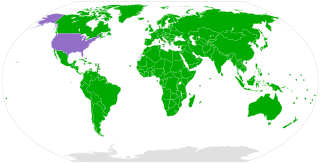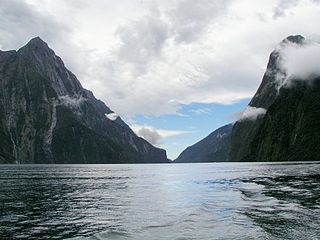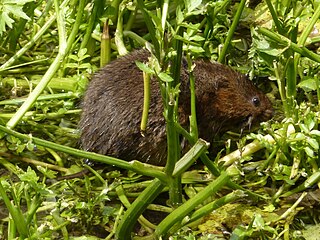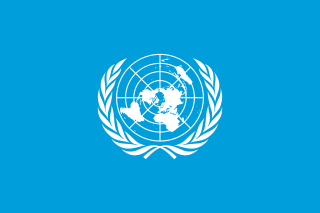
The Convention on Biological Diversity (CBD), known informally as the Biodiversity Convention, is a multilateral treaty. The Convention has three main goals including: the conservation of biological diversity ; the sustainable use of its components; and the fair and equitable sharing of benefits arising from genetic resources.
The Cartagena Protocol on Biosafety to the Convention on Biological Diversity is an international agreement on biosafety as a supplement to the Convention on Biological Diversity effective since 2003. The Biosafety Protocol seeks to protect biological diversity from the potential risks posed by genetically modified organisms resulting from modern biotechnology.

Agricultural biodiversity is a sub-set of general biodiversity. The Convention on Biological Diversity (CBD) defines it as

Marine protected areas (MPA) are protected areas of seas, oceans, estuaries or large lakes. These marine areas can come in many forms ranging from wildlife refuges to research facilities. MPAs restrict human activity for a conservation purpose, typically to protect natural or cultural resources. Such marine resources are protected by local, state, territorial, native, regional, national, or international authorities and differ substantially among and between nations. This variation includes different limitations on development, fishing practices, fishing seasons and catch limits, moorings and bans on removing or disrupting marine life. In some situations, MPAs also provide revenue for countries, potentially equal to the income that they would have if they were to grant companies permissions to fish.

The term megadiverse country refers to any one of a group of nations that harbor the majority of Earth's species and high numbers of endemic species. Conservation International identified 18 megadiverse countries in 1998. Many of them are located in, or partially in, tropical or subtropical regions.
Natural heritage refers to the sum total of the elements of biodiversity, including flora and fauna , ecosystems and geological structures.

The United Kingdom Biodiversity Action Plan or (UK BAP) was the UK government's response to the Convention on Biological Diversity, opened for signature at the Rio Earth Summit in 1992. The UK was the first country to produce a national Biodiversity Action Plan. It was published in 1994 and created action plans for priority species and habitats in the UK that were most under threat so as to support their recovery.
The Biosafety Clearing-House is an international mechanism that exchanges information about the movement of genetically modified organisms, established under the Cartagena Protocol on Biosafety.

The Environment Protection and Biodiversity Conservation Act 1999 is an Act of the Parliament of Australia that provides a framework for protection of the Australian environment, including its biodiversity and its natural and culturally significant places. Enacted on 17 July 2000, it established a range of processes to help protect and promote the recovery of threatened species and ecological communities, and preserve significant places from decline. The EPBC Act replaced the National Parks and Wildlife Conservation Act 1975.

A biodiversity action plan (BAP) is an internationally recognized program addressing threatened species and habitats and is designed to protect and restore biological systems. The original impetus for these plans derives from the 1992 Convention on Biological Diversity (CBD). As of 2009, 191 countries have ratified the CBD, but only a fraction of these have developed substantive BAP documents.
Canada's Biodiversity Outcomes Framework was approved by Ministers responsible for Environment, Forests, Parks, Fisheries and Aquaculture, and Wildlife in October 2006. It has been developed further to the Canadian Biodiversity Strategy, an implementation measure required under Article 6 of the United Nations Convention on Biological Diversity.
Canada's Biodiversity Convention Office (BCO) serves as National Focal Point for the United Nations Convention on Biological Diversity and the Canadian Biodiversity Strategy. BCO also provides a leadership role in the Biodiversity Conservation Working Group of the Commission for Environmental Cooperation and in the Conservation of Arctic Flora and Fauna (CAFF) working group of the Arctic Council.

The International Year of Biodiversity (IYB) was a year-long celebration of biological diversity and its importance, taking place internationally in 2010. Coinciding with the date of the 2010 Biodiversity Target, the year was declared by the 61st session of the United Nations General Assembly in 2006.

Uea is a high rocky offshore island of Rotuma. Uea is one of a number of outliers lying off the west coast of Rotuma. It is the second largest island and is the highest island in the Rotuma Group with an elevation of 260 metres (850 ft).
The United Nations General Assembly declared 2011–20 the United Nations Decade on Biodiversity. The UN Decade on Biodiversity serves to support and promote implementation of the objectives of the Strategic Plan for Biodiversity and the Aichi Biodiversity Targets, with the goal of significantly reducing biodiversity loss.
Formed in 2000 and launched globally in 2005, the Alliance for Zero Extinction (AZE) comprises 100 non-governmental biodiversity conservation organizations working to prevent species extinctions by identifying and safeguarding sites where species evaluated to be Endangered or Critically Endangered under International Union for Conservation of Nature (IUCN) criteria only exist at one location on earth. AZE members work to rebuild populations of endangered and critically endangered species through efforts to eliminate human threats such as commercial exploitation, disease and the introduction of invasive species. AZE provides expertise on biodiversity goals for the Convention on Biological Diversity (CBD) and assists party nations in integrating protection of AZE sites and species into National Biodiversity Strategies and Action Plans (NBSAP). Country-based initiatives, or national Alliances for Zero Extinction, have begun to take shape recently representing partnerships of government agencies and non-government organizations to accelerate the protection of AZE sites in compliance with national commitments under the Convention on Biological Diversity.

This is a list of topics in biodiversity.
The Biological Diversity Act, 2002 is an Act of the Parliament of India for preservation of biological diversity in India, and provides mechanism for equitable sharing of benefits arising out of the use of traditional biological resources and knowledge. The Act was enacted to meet the obligations under Convention on Biological Diversity (CBD), to which India is a party.











